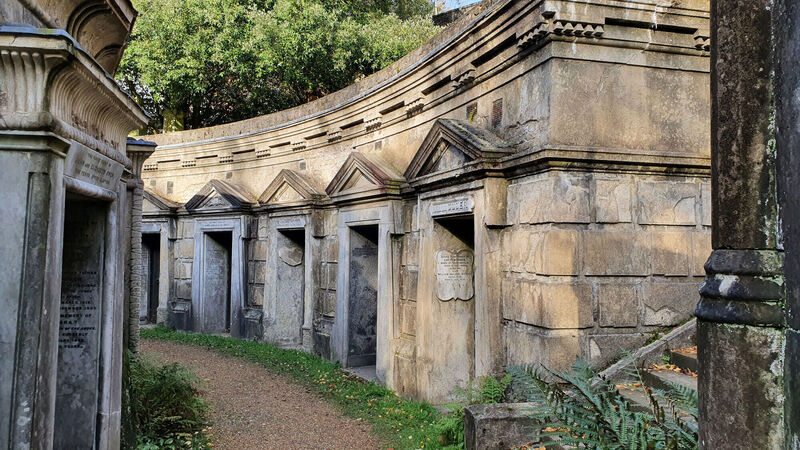Michael Moynihan: We know more on burial sites of French than Bessborough children

Highgate Cemetery in London, where a search is being launched for designers and architects to help conserve the world-famous site. Picture: PA
Stop me if you’ve heard this one before, but I don’t think you have.
Are we making enough of the city’s cemeteries? The historic ones in particular?
I ask because a reader was kind enough to point me towards a new book which looked, he said, like the “kind of thing you’d be interested in — a bit weird, in other words”.
Correct, gentle reader. The book is .
Ross’s book is an engaging ramble among the gravestones and burial plots of Britain (and Ireland, as he tells the heartbreaking story of a cemetery guide in Glasnevin Cemetery, Dublin.)
He shows that an eye-catching gravestone inscription can be the spark to set a curious mind chasing the details of an extraordinary life, a template that would serve any reader well if he or she finds themselves strolling around a cemetery any time soon.
Well, either that or those readers could maybe make a few bob selling cemetery-branded calendars or mugs to other visitors.
Let me explain: cemetery tourism appears to be having a moment.
London’s Highgate Cemetery, I read recently in , is to be remodelled for the 21st century. Not only is it to be remodelled, it is to be monetised: “In addition to a spot of landscaping, it will have an exhibition space, a separate gift shop and possibly a cafe.
“Home to the remains of 170,000 people, Highgate, which opened in 1839, is the latest cemetery seeking to capitalise on the public’s growing interest in death.
“Brompton cemetery in south London has recently been given a makeover which saw buildings restored and a lodge turned into a visitor centre with the help of a £4.5m grant from the National Lottery Community Fund.”
Yes, you read that correctly. A gift shop.
A trust which runs Highgate is to hold a design competition for the redevelopment, though a spokesperson did say that “a very light touch” would be needed for the cemetery.
Read More
Well, quite.
But as an added twist, I did note one killer line in that piece which throws all those plans into sharp relief: “Highgate, which today draws 100,000 paying visitors a year, up from 63,000 seven years ago.” A quick Google search shows admission prices ranging from £4 to £12. Multiply those sums by 100,000 and a gift shop doesn’t seem quite so outlandish a notion, does it?
Of course, you can also enjoy the fact that one of Highgate’s main attractions is the tomb of Karl Marx, which means these plans for expansion are just the fuse for an explosion of heavy puns about capitalism which I won’t detain you with here.
Though the fact that a lot of those entry fees are presumably paid by people wanting to see the resting place of the father of communism isn’t lost on me.
There are certainly graveyards in Cork which could tell us much about the city’s history even if they aren’t quite as expansive as Highgate.
Take the Huguenot cemetery in Carey’s Lane, right next to French Church Street (a name that gives the game away).
It’s one of the last remaining indications of the presence of members of the French Protestant sect, many of whom came to Ireland around the turn of the eighteenth century, fleeing religious persecution in their home country.
(If they were looking for religious freedom in the Ireland of the eighteenth century then the France of the eighteenth century must have been a grim posting indeed.) The few tombstones you can pick out if you stand on the lane and look in past the metal barrier are pretty forlorn, when you come to it.
But at least the Huguenots are commemorated. If you press up against the metal you can learn about them from the large plaques placed within the cemetery.
Here was a community of some 300 people which found its way to Cork centuries ago and established itself.
It was a community which saw its children grow up speaking a foreign tongue before scattering themselves around the globe; a group which enjoyed its triumphs and endured its own little tragedies while seeing the steady decline of their traditions as they assimilated.
Take their native tongue: for about one hundred years they had religious services in French, but gradually that need disappeared, and early in the nineteenth century French services ceased in favour of Wesleyan rites in what was known as the ‘French Church’.
Still, we know Huguenots were interred in the burial grounds by the names: Goble, Hardy, Le Grand, Madras, Malet, Perrier and Pique.
You don’t have to work your imagination too hard to picture these sober Frenchmen striding along the quays of Cork en route to a silversmith’s or the customs house.
Their disappearance — or absorption into the population if you want to be upbeat — is pretty sobering once you stop and take the time to absorb the lesson of the cemetery.
Though I’m always cheered by the company those almost-forgotten Huguenots keep in that lane.

Just a few steps across from the cemetery itself there’s Fellini’s coffee shop, which means the rich aroma of good coffee comes across and through the gates. Right next door to the cemetery you can find Cafe Mexicana.
There’s something in the odour of burritos and churros and lively mariachi tunes wafting over those tombstones that’s life-affirming.
The obvious conclusion, therefore, is that cemeteries are a gateway to the past and a means of appreciating one’s heritage.
What happens, though, when that heritage isn’t acknowledged, let alone appreciated?
Take a report from Eoin English of this parish last week.
The Cork Survivors and Supporters Alliance, which represents over 50 families of children who died at the former mother and baby institution at Bessborough in Cork city, called on developers to withdraw applications for a site close to that institution until the Mother and Baby Homes Commission of Investigation’s final report.
The Alliance believe the proposed development overlaps a children’s burial site; the developers don’t, telling this newspaper that archaeologists believe there is no evidence to suggest that the proposed development site contains any undocumented burials associated with the former Home.
Your columnist’s map-reading skills aren’t up to the task of determining which side is right in this case.
But the wider point is that the final resting places of hundreds of children who died in Bessborough over the decades remain unknown.
Until all of those children can be accounted for, this episode will continue to be a shocking stain on this country’s history.
Gift shops and cemetery visitor centres seem like a bad joke when nobody seems to care about what happened to them.
Apart from groups like the Cork Survivors and Supporters Alliance, that is. Long may their savage indignation burn for those children.






